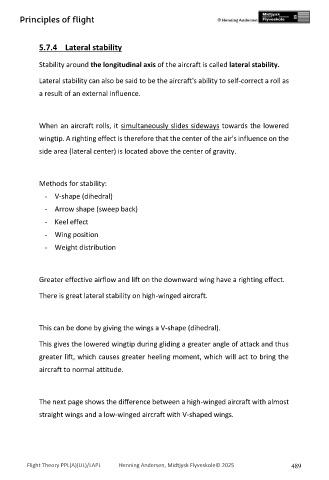Page 489 - PPL-engelsk 2025
P. 489
Principles of flight
5.7.4 Lateral stability
Stability around the longitudinal axis of the aircraft is called lateral stability.
Lateral stability can also be said to be the aircraft's ability to self-correct a roll as
a result of an external influence.
When an aircraft rolls, it simultaneously slides sideways towards the lowered
wingtip. A righting effect is therefore that the center of the air's influence on the
side area (lateral center) is located above the center of gravity.
Methods for stability:
- V-shape (dihedral)
- Arrow shape (sweep back)
- Keel effect
- Wing position
- Weight distribution
Greater effective airflow and lift on the downward wing have a righting effect.
There is great lateral stability on high-winged aircraft.
This can be done by giving the wings a V-shape (dihedral).
This gives the lowered wingtip during gliding a greater angle of attack and thus
greater lift, which causes greater heeling moment, which will act to bring the
aircraft to normal attitude.
The next page shows the difference between a high-winged aircraft with almost
straight wings and a low-winged aircraft with V-shaped wings.
Flight Theory PPL(A)(UL)/LAPL Henning Andersen, Midtjysk Flyveskole© 2025 489

